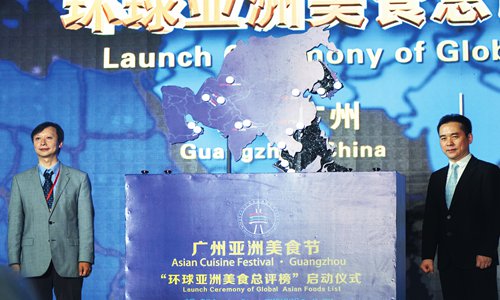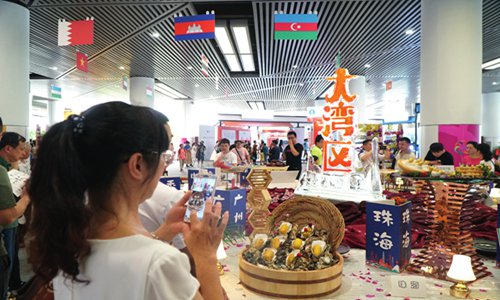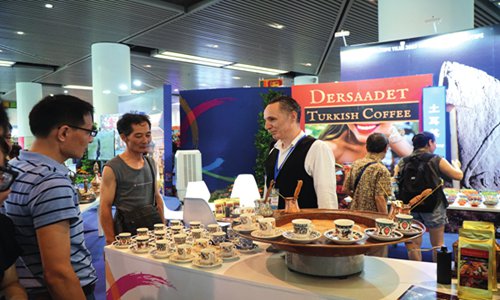HOME >> BUSINESS,METRO BEIJING
Asian flavors
By Li Jieyi Source:Global Times Published: 2019/5/20 19:01:16
People talk about food and more at Guangzhou’s Asian Cuisine Festival

Zhu Xiaoyi (right), deputy director of the Publicity Department of the Guangzhou Municipal Committee of the CPC and Xie Rongbin, deputy editor-in-chief of the Global Times, unveil the launch ceremony of Global Asian Foods List on Friday, at the Haixinsha Asian Games Park, Guangzhou, Guangdong Province. Photo: Li Jieyi/GT

A Guangzhou citizen takes a photo of the Guangdong-Hong Kong-Macao Greater Bay Area cuisine display at the World Cuisine Collection. Photo: Li Jieyi/GT

Local people gather around the Turkish coffee display at the World Cuisine Collection. Photo: Li Jieyi/GT
Shiny shell souvenirs were placed in a stall, and some Filipinos stood in front of it wearing their traditional clothes made of pineapple fiber. The Chinese lined up in front of the stall to taste the drinks. Also in the stall, there was Filipino food. It is one of many stalls on the scene of the World Cuisine Collection held at the West Zone of Haixinsha Asian Games Park in Guangzhou, Guangdong Province. Each of the foods belongs to a certain country or a local company where cuisines, snacks and souvenirs were showcased. "The event is great, and it allows us to learn about different cultures," said a woman surnamed Sun from Southwest China's Chongqing.
It's one of the highlights of the Asian Cuisine Festival, which is hosted by Guangzhou. On Thursday, the opening ceremony of the festival was held in the city as a part of the Conference on Dialogue of Asian Civilizations (CDAC), which features delicacies from Asian countries, forums and culture performances. People from different cultural backgrounds got together to taste delicacies and experience the diverse cultures.
Food: a universal topic
Food is a basic necessity for people and when you go to a new place, understanding cultures usually starts by understanding their food. When Tadeo Berjón, Deputy Consul General of Mexico in Guangzhou, arrived the city a year ago, he didn't like dimsum very much. "But now I love it," he said. For many, the morning tea in Guangzhou reflects a slow-paced lifestyle and is a way of social communication, which is enjoyed by many people. Drinking traditional morning tea has been rooted in the daily lives of local people.
They call it Yum Cha, in local dialect or having Zao Cha, which means "drink tea." Shrimp dumplings and Siu Mai are two widely known types of dimsum when having Zao Cha. Each of the dishes is served in small portions so people can taste various kinds of dimsum in a sitting. Berjón has dimsum at least once every two weeks with his friends. "My friends would introduce me to all sorts of delicacies, so it's an exciting voyage," he said.
Suchitra Chongstitvatana from Thailand is a professor and Chair of the PhD program at Chulalongkorn University. "People love food naturally," she said in an interview with the Global Times after attending a forum on food and culture during the festival.
The philosophy hidden behind the food might be accepted and believed by people with different cultural backgrounds, she added.
"The Cantonese people see food as medicine sometimes, and so do the Thais," said Chongstitvatana.
Kim Tae-Hyun, Consul of the Republic of Korea in Guangzhou said, "We eat ginseng chicken soup in the summer because we believe that we control heat through heat," he said.
And this kind of theory can also be heard in traditional Chinese medicine. Although the ingredients or the way of cooking might vary from different countries and regions, there are still similarities that can be found when it comes to food.
Dialogues of delicacies
The host country day is a special activity in the festival as well. Countries are chosen to serve their traditional food on certain days, which enable the guests savor the different cuisines and cultures. May 18 was South Korea's day to host. Cho Kyung Kyn, a well-known comic artist specializing in drawing anime about food, was invited to the day's opening ceremony and talked to the local Chinese. When he was a college student studying in the US, he loved to go to Chinatown and eat Chinese food. "It was so delicious, it drove me to draw the food," said Cho.
His series of comic strips include a book of Cantonese and Beijing cuisines, which have become a hit in South Korea. Many young Koreans traveled to Guangzhou and Beijing after being influenced by his book, he said.
"It's the combination between food culture and anime industry," said Zhu Xiaoyi, deputy director of the Publicity Department of the Guangzhou Municipal Committee of the Communist Party of China (CPC).
Anime was popular among Chinese young people and the anime industry is a component of Guangzhou's economy. According to lifeofguangzhou.com reported in 2017, Guangzhou is home to nearly 400 comics and animation companies. "This kind of combination might have good influence on the young people," Zhu said.
"And as a relative part of the CDAC, we hope the Asian Cuisine Festival will not only become a way for people to savor delicacies from different countries, but also a platform for multiple civilizations to communicate."
The launch ceremony of Global Asian Foods List was also held during the festival. The event was jointly launched by the Publicity Department of the Guangzhou Municipal Committee of the CPC and the Global Times. "We chose the Global Times for its international view," Zhu said, adding that they hope the Asian Cuisine Festival could become an annual event promoting mutual learning and cultural exchanges among different civilizations.